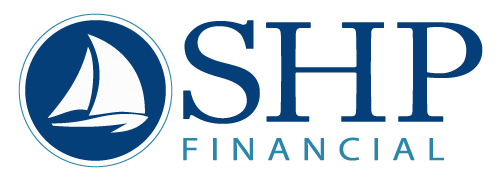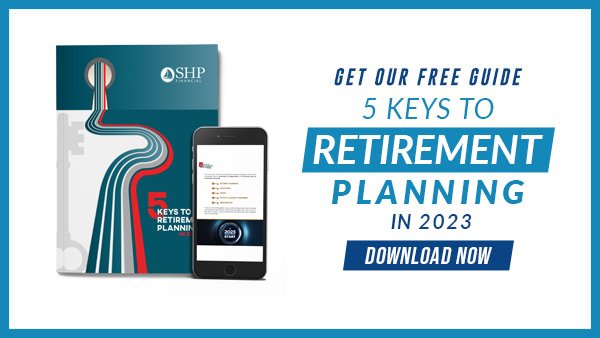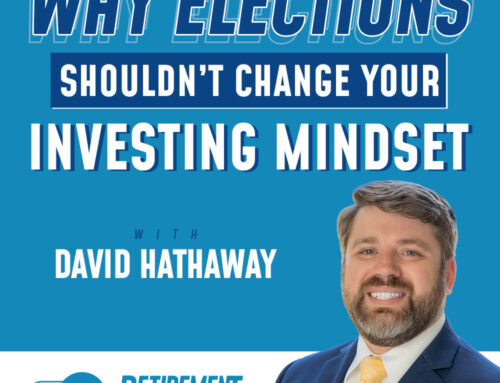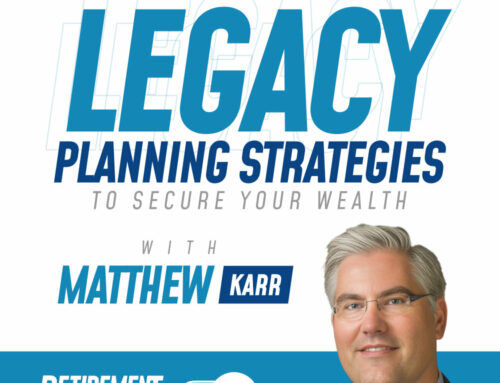It’s a new year and on behalf of everyone here at SHP Financial, we hope you had a wonderful holiday season and a great start to 2023.
For many people, a new year starts off with a New Years’ resolution. Perhaps one of your resolutions is to take a closer look at your finances and reduce your stress about money.
If that’s the case, you’ll want to ring in the new year with Matthew Peck and Keith Ellis, Jr. as they share their top 3 financial planning tips for a new year.
Whether you need help with making the changes to your portfolio, managing your monthly budget, or making your 401(k) and IRA contributions, that’s what we’re here for because that’s what comprehensive financial planning is all about.
In this podcast discussion, you’ll learn:
- The value of rebalancing and readjusting your portfolio. Whether you’re investing on your own or you’re already working with SHP, a new year is an opportunity to reevaluate your circumstances.
- How target date funds can help rebalance your portfolio, especially as you get closer to retirement.
- Review your monthly budget and expenses. Especially with high inflation.
- Make sure that you’re fully benefiting from new 401(k) and IRA contribution limits and maximizing the income tax benefits.
Inspiring Quotes
- “We’re always trying to create that little bit of a margin or cushion in there just to create that wiggle room on the positive end of it.” – Matthew Peck
- “It’s very important to have different buckets of money that have different purposes and I always use the word to have purpose around your plan.” – Keith Ellis Jr.
Matthew Peck: Well, hello again, and welcome to the SHP Retirement Road Map podcast. I’ll be your host today, Matthew Peck, and joining me is Keith Ellis, fellow SHP co-founder and also a fellow 20-year veteran of this universe and this industry of SHP. But today, we’ll be talking about the three top things that you should be doing at the beginning of the year, the areas that you should be exploring, as the calendar, you tear off December. Christmas and New Year’s is now over. You take a deep breath. But like always, now it’s time for work or there’s always work to be done. And we’ll be talking about our top three takeaways to conduct at the beginning of the year. But before we get into those planning tips, let me bring on Keith Ellis. How are you, my friend? And how was your holidays?
Keith Ellis, Jr.: Yeah, they were great. I mean, too fast. Like always, every year, same thing, it goes too fast. Another year, kids get older. It’s tough to watch but fun. You know what I mean? Because you want to keep them young forever.
Matthew Peck: Santa Claus still exists in the Ellis household or not?
Keith Ellis, Jr.: Santa Claus is alive and well.
Matthew Peck: Okay, good. I didn’t know if the bubble had burst. My 13-year-old, the bubbles burst.
Keith Ellis, Jr.: Oh, that’s too bad.
Matthew Peck: But I didn’t know if…
Keith Ellis, Jr.: Just don’t ruin it for the other one.
Matthew Peck: Correct. Yeah, he knows the drill.
Keith Ellis, Jr.: But, yeah, to turn the page, 2023, and now our 20th year in business, it’s where time go– it goes so fast.
Matthew Peck: It’s amazing. Just so all of our listeners know, there’ll be sort of some festivities coming up, to say the least. But it was in September of 2003, some smartphones were not around, not much of the iPhone even existed. The Internet was there. I see Evan, our producer, smiling right now because he’s like, are you sure? Like we did that. I think we had rotary phones. I think I wired Keith.
Keith Ellis, Jr.: iPhones are still in existence.
Matthew Peck: But in all joking aside, I think when we first started out insurance way back when we got beepers. So, that was the extent of being…
Keith Ellis, Jr.: Communication.
Matthew Peck: Yes. Who would beep an insurance agent, by the way? I still don’t know, like I need life insurance stat.
Keith Ellis, Jr.: Yeah, yeah, yeah. I don’t know. I remember having the beeper for about three days and just being like, I don’t want to use this. So, I didn’t. It’s just like, I just believed in picking up the phone and calling and having conversation more than beeping. Or if someone needed anything, they would call me.
Matthew Peck: Yeah, right.
Keith Ellis, Jr.: I really needed more communication like that. Beeping was just silly, I think.
Matthew Peck: Yes, it went the way of the dodo. So, there will certainly be– I’m sure we’ll probably have a dedicated podcast to what it’s been like over the past 20 years and sort of where we started to where we were doing SHP has become, but as I said, today is more about what planning we need to do now that the holidays are through, now that sort of the cold reality of January is with us. But also, we’re obviously hopeful because I love the whole Happy New Year popping champagne because 2022 is now behind us. And let’s hope certainly for at least a more fruitful 2023 in the markets and everything else there.
But as we turn the page on a new calendar, we’re going to be talking about our top three tips to begin that planning because everything we talk about here is having a comprehensive plan, making sure that all five areas are covered – investments, tax planning, income planning, health care, legacy planning. That is the level of comprehensive planning that you need and frankly deserve, whether you’re approaching retirement or are already retired. These are the areas, as you can see, that you should have, making sure that’s being covered and discussed and brought to your attention by whomever the advisor might be.
So, okay, Keith. So, again, we turn the page to beginning-of-the-year planning. What’s the number one tip that you give your clients as you approach a new year?
Keith Ellis, Jr.: I mean, I don’t know if it’s the number one tip, but it’s definitely something that I would look at is kind of rebalance and readjust, look at your portfolio, right? For folks that are doing it themselves or maybe they have a 401(k) that they’re still contributing to, a lot of people have that set-it-and-forget-it mentality with 401(k)’s. Obviously, if you’re working with us, we’re rebalancing the portfolio as we’re doing all that along the way for you.
But sometimes, like I said, those folks that have 401(k)’s, 403(b)’s retirement plans that they’re just putting money into, they never make the adjustments. And you’re another year older, another year closer to potentially retirement. And you want to make sure you’re making adjustments mainly to risk and maybe potential opportunities, maybe the companies added new funds and you haven’t paid attention to that or whatever it is, spend some time and learn a little bit more about your 401(k), 403(b), your retirement accounts. After all, they’re the things that are going to really push you through the next 25, 30 years after you do retire. I mean, it’s an important aspect, it’s a cornerstone of what it is you have in a lot of cases.
Matthew Peck: And I just want to go back because I know we’re talking about the 20-year our own sort of anniversary coming up in September, but really, I mean, it’s amazing how time passes. And I know it’s cliché and that’s fine, of course, but just more the idea that as you were saying, with each passing year, you are that much closer to retirement. No, very often, a lot of these 401(k)’s will have what are called TDFs or target date funds. Now, interestingly enough, or frustrating, I should say, is that a lot of those target date funds are not too well in 2022 in the sense of, and I mean, actually, let me step back and explain.
So, a lot of these 401(k)’s, we’ll have what’s called a target date fund where when you first enroll to mutual fund and it will be a 2040 fund or a 2045 fund or a 2030 fund or a 2025, it’s like a target date year on a mutual fund that should be getting more and more conservative the closer you get to that actual year. So, in theory, the 2025 fund is going to be a whole lot more conservative than the 2050 fund because people that are retiring in 2025 are only two years away. Now, as I said, what was kind of maddening in 2022 was that a lot of these target date funds that were “conservative” did not hold up as well. And that was because of sort of the carnage that happened in the bond market.
So, if you do have one of those target date funds in your 401(k), the portfolio should be naturally rebalancing as each year passes. Now, that’s not to say it’s for everybody, and certainly, you want to be aware of the underlying risk in that fund no matter what happens. But then also, very often, people don’t choose the target date funds, and then they’ll have sort of a slew of options. And when was the last time you took a look at those options? Because to your point, I mean, there’s a lot of change that’s happening within 401(k)’s and companies are constantly coming out with new investment selections within their 401(k).
Keith Ellis, Jr.: And I think not only investment selection, but now let’s talk about tax selection.
Matthew Peck: Yeah, right, absolutely.
Keith Ellis, Jr.: Right? So, a lot of 401(k)’s that we run for small businesses in the area, when we go in, we notice that one of the options that a lot of 401(k)’s hasn’t had previously that we’ve been adding in is what’s called a Roth option, the ability for the employee and employers to make their contributions to a Roth 401(k), and it depends on the circumstance whether that could be right or wrong for you, but I think, for some of these young kids, these median income earners now, as they start to grow their career, it’s a great opportunity to just start to put money away and have that money in perpetuity grow tax-free. I love the fact that I’m seeing more and more employers start to add that.
And I know one of the first things I do when I look at a 401(k) plan, a client comes in or a business owner comes in and says, “Look, I have a 401(k) for my business. Can you guys take a look at it? What am I paying in fees? What are the third-party fees? What are the different options? Should I have more options?” And one of the things we automatically start to look at is that option, and then if we are lucky enough to take that account over, one of the things we bolt right on there is the ability to grow that money tax-free.
I have business owners that make quite a bit of money, and they’re still putting it in tax-free just because they say, “Look, I don’t want to deal with the federal government later. I just don’t want to. I know this might not be the best decision now because I think I’m paying a little bit more in taxes but to have this money compound for 10, 15, 20, 25 years tax-free, that to me is more attractive.”
Matthew Peck: Well, and as a partner, that’s really the key part I want to make sure our listeners know about is the fact that you can earn $500,000, $600,000, or $700,000 and still be able to put money away via a Roth 401(k).
Keith Ellis, Jr.: Where you can’t with an IRA.
Matthew Peck: Correct, yeah. So, ordinarily when it comes to Roth IRA dollars, the limit, the joint income, the household limit is roughly about $200,000, which means that if you are a high net worth as a family combined owns or earns more than roughly about $200,000, you can’t contribute to a Roth IRA. However, the Roth 401(k), as you’re mentioning, Keith, does not have those types of income limits. So, you have higher net worth or higher net income earners that can absolutely put money away into a tax-free vehicle that you were saying that grows compounded year over year, now you’re going to be just growing this bucket of tax-free dollars for your retirement. I mean, to not take advantage of that is just sort of just a waste, to say the least.
Keith Ellis, Jr.: Yeah. And a lot of times when we are digging into these plans as well, we’re noticing, they could be a little bit higher in fees. Not only are we making the adjustment from a tax perspective adding potentially more investment opportunity on the platform, but a lot of times, we’re able to even reduce the fees for the person who owns the business who’s spending the money to fund the business to save their money and do these other options and to give them a team of advisors that their employees can rely on. To us, that’s a massive win in regards to a lot of these small businesses who just don’t want to do that.
Matthew Peck: Yeah. So, summarizing the first one, the first tip is to make sure you’re rebalancing portfolio, specifically within the 401(k) front. Obviously, if you have your own portfolios to IRAs, I mean, father time always wins, and so, time is obviously clearly moving on as we enter a new year so taking the opportunity to make sure that your portfolio is matching where you are in your life. And so, if you have a target date fund, great, that should be happening naturally. What other options do you have in your IRAs or 401(k)’s or brokerage accounts?
And as Keith was mentioning, what type of contribution options, tax contribution? We’re going to be talking about contribution limits in a minute, but the whole idea of making sure that if there is a Roth 401(k) option, you explore it. And if you’re self-employed, like Keith was mentioning, I would certainly recommend reaching out only to what is your existing broker or someone like us to modify your 401(k) and to potentially consider adding a Roth option into it. So, rebalancing your portfolio to match where you are in your life in the tax situation is our tip number one.
Number two is regarding reviewing your budget and expenses. I mean, this is something that I think that it’s almost like every single client that comes in for an annual review, whether it’s January or not, I always begin the conversation with, “Okay, what’s your budget? What’s your spending?” I mean, what have you been seeing? Or I guess, Keith, what do you tell clients in regard to their budget? And then how has inflation affected a lot of your clients? I mean, is that the first word that’s been in their mouth too?
Keith Ellis, Jr.: Yeah, I think a lot of folks, obviously, I mean, everybody’s been impacted by inflation. It’s funny, I see this time and time again, a family will come in, three or four years ago and they have $100,000 that they need net income. And then what we do is we adjust their plan going forward for cost of living. And then we’re able to show them projected year after year where they’re going to be all the way out to 90s, even 100 years old if they want to look at it that far.
So, first of all, that to me, if you look at your portfolio that is growing over time or staying stagnant over time with all the spending that you’re incurring, that’s an empowering feeling. That’s a way, that should give you confidence to spend more, like I said, to gift more, to do the things that you want to do and enjoy your retirement. And to answer your question, what I’ve noticed is, yes, inflation has impacted people significantly, but for whatever reason, the families that I work with, or a lot of families, they have the ability to make that dollar stretch.
Matthew Peck: Yeah, right.
Keith Ellis, Jr.: You know what I mean? They really do. I don’t know how they do it and I think it’s a really unique thing, but that family that needed $100,000 three years ago still needs $100,000.
Matthew Peck: Yeah.
Keith Ellis, Jr.: So, to answer you, kind of that same conversation come in. Hey, we’re still living off the same thing. How are we doing? Is everything tight? Are you able to do it? Yeah. Okay, I mean, obviously, we can make adjustments as we go forward. So, if things change in three months, six to eight months from now, let us know. We’ll make the adjustments, we’ll revisit the plan, but we’re going to march forward as is. And you guys are doing a great job, and it’s amazing how they do that.
Matthew Peck: I would agree. I mean, it’s funny that you say that because more often than not, I’ve had people similar. I mean, they’re not that unhappy about having to pay more at the gas pumps and whatnot. And certainly, the food has gone higher. But yeah, I think maybe some planners or savers are able to really stretch that dollar. That could be it.
Keith Ellis, Jr.: And they’re not living less. They’re still traveling, they’re still giving to their grandkids. Their bucket list is being hit, their goals are being hit. It’s just they’re able to stretch that dollar. It’s a funny thing, but it happens.
Matthew Peck: Well, and I’d also say too, a lot of them when it comes to our planning, Keith, I think is obviously not to pat us too much on the back, but we certainly do put in a cushion when we are building on a plan for somebody because the foundation of a good financial plan, in our opinion, is an income plan.
Keith Ellis, Jr.: Correct.
Matthew Peck: Right? And so, at least, we initially see people and then they come in, whether it’s Plymouth or Woburn or Hyannis or Braintree or wherever it may be. The first thing that we’re doing is looking at their expenses and looking at their income gap, but we’re also trying to inflate their expenses in the sense of creating a cushion so that okay, oh, you guys think you spend $6,000. All right, we’re going to plan for $7,000.
Keith Ellis, Jr.: Exactly, yes.
Matthew Peck: But we’re always trying to create that little bit of a margin or a cushion in there just to create that wiggle room on the positive end of it. So, we want to overestimate their expenses or overestimate their spending.
Keith Ellis, Jr.: But I think that’s maybe taken a little bit more of a conservative look at everything.
Matthew Peck: Right, exactly.
Keith Ellis, Jr.: Planning for the worst, managing for the best. Does that make sense?
Matthew Peck: For sure. And again, I think that’s a part of our philosophy here is to really kind of hoping for the best minute, expect the worst. But the other thing, too, you mentioned about gifting to grandkids. We certainly want to make sure that when people are taking a look at their budget for 2022, are there any big one-offs? A client of mine, actually, I think, like two or three clients off the top of my head that their son or daughter is getting married. And so, let’s say they ordinarily spend $7,000 a month. Well, this year, they are going to be $7,000.
Keith Ellis, Jr.: It’s changed a little.
Matthew Peck: Right. Gives you $7,000 a month plus about $30,000 for a wedding. So, you’re sitting down, taking a look at your budget with your financial planner, whomever it may be, ask yourself that question of are there any one-offs that are not ordinarily there – weddings, big travel, new car, renovations, whatever that may be, because certainly, there are the unintended or unexpected black swan-like health events, and if your car breaks down, I mean, obviously, that certain stuff you can’t control. I’m not sure how about you, but I obviously had a couple of clients down in the Fort Myers area that when Ian came through, and so, they suddenly had a whole lot more spending on their properties down there. Yeah, so those types of events you can’t necessarily see coming, and again, same as health care.
But the reason why we talk about these one-offs and baking these one-offs into your budget is that you want to be careful of what’s called sequence of return risks. What that means is it’s a fancy way of just saying that if we are raising a large amount of cash, you want to be very cautious about where the markets are or where you’re pulling it from, because if the markets are off 20%, 30%, whatever that may be, and if your portfolio is in that similar boat in that low tide area, then suddenly, you’re selling cash. And now, we have $30,000 or $40,000 that you just took out that you’re never going to have back because of when you took it and what the market was doing. So, I mean, remember, with sequence of return, sometimes we’ll talk about that in the seminar. I remember the two brothers’ things we used to do back in the day, but I guess how often does that come up or how often are you warning people on that to beware of that concept?
Keith Ellis, Jr.: All the time. It’s one of the main things that I think we build into every plan is to have a bucket, for lack of a better way of putting it, a pot of money that is either fixed or more conservative to be able to dry run in a down market. A lot of times, like you said, we’re building in strategies, whether it’s CDs, fixed annuities, fixed indexed annuities, something that is safe, even a conservative allocation that allows a good chunk of money to be set aside for times like these because our philosophy is you need money for safety, money for income, and then money for growth.
And the idea is that growth bucket needs to be looked at long term. That’s your market bucket. And there’ll be years where you take money out of that because maybe you’ve made, like 2019 was a great year in the market. So, if you have all those gains that are going to support your income, why not take those chips off the table and you get a free year’s worth of income? You know what I mean?
Matthew Peck: Yeah, right.
Keith Ellis, Jr.: And within years, like 2022, with the markets down, you don’t want to sell at a down. As much as possible, you want to keep your money invested so then it recovers with the market, and then you haven’t sold at that bottom. So, it’s very important to have different buckets of money that have different purposes. A lot of folks, when they retire, they’ll come in and visit with us and they’ll just have everything in one allocation. It’s like, well, that’s great and it’s easy to understand, but the problem you’re going to have is and there hasn’t been a problem up until 2022, right? Because we haven’t really had many down periods or down pockets of time. And now, people see the importance of having these different buckets that have different purposes, that have different growth, that are maybe a little bit more conservative for times like 2022. So, I think it’s really important, and I always use the word to have purpose around your plan.
Matthew Peck: Excellent. And so, it’s funny about the allocation aspect, and I’ll do one last little bit before I move on is that very often, we have people that will work for one individual company and they work for that company for all those years, and they end up with that one company stock.
Keith Ellis, Jr.: Oh, yes.
Matthew Peck: And they’ll come in, maybe it’s because they had such a relatively good career, maybe they had good people there, good feelings or whatever, they want to hold on to that one company stock. Like it’s…
Keith Ellis, Jr.: It’s a very risky allocation.
Matthew Peck: Yeah, correct, because any one individual company, no matter how good or bad, can suffer from what’s called business risk, where if that company suffers at the wrong time that you then need that asset for a wedding, for travel, or just for spending, you need to make sure because that would fall into that trap of sequence of return risks with that business risk on top of it. All right, so let me just review the two issues, and then I’m going to end with the contributions that if you don’t mind, Keith, I’m just going to rattle off just so everyone knows.
So, before I summarize everything, the last bit of tip to do in the beginning-of-the-year planning is just to be aware of the new contribution levels. Okay? So, with inflation and with taxes, with everything going up every single year, how much you can contribute to a Roth, how much you can contribute to your 401(k), how much you can contribute to an HSA goes up year after year. And so, the last part that I want to make sure of is to get on top of your contributions. We want to make sure that you are adding to all of the buckets, if you can, especially the 401(k)’s because if you have free money, we want to get your free money.
But the new contribution limits for these numbers are, for IRAs and Roth IRAs, it’s $6,500 or $7,500 per person, depending on whether or not you’re above or below age 50. So, $6,500 and $7,500 are the amounts, again, based on age. I should quickly state that there are income limits with these contributions. So, it’s not just for everybody, but just to be aware, they’re $6,500 and $7,500.
Then also, 401(k)’s are $22,500 if you’re under 50, or $30,000 if you’re over 50. So, people that are over 50 that are 10, 15 years away from retirement, you can now put up to $30,000 per year. And it might be Roth 401(k) dollars like we talked a little bit about earlier. Keith. So, that’s a big chunk of change. And ideally, you’re in your 50s, that should be your highest income years, if you will, so really be aware of the new limits. And we really want to max out those limits, especially getting that free money.
And then last but not least is the HSAs. HSAs stands for health savings accounts. So, we certainly want to make sure that people, if they are putting in a way into that type of health insurance program with a savings account kicker that that single individual, it’s $3,850 for single, and then family is $7,750 are those contributions to HSAs. So, we want to get those funds moving. We want to get them invested as soon as possible because you want to have time on your side to be making those contributions.
So, in review of the three top things that we tell people to beginning-of-the-year planning is rebalance, to take a look at your portfolios and/or 401(k)’s. A year has passed, you are now going to be one year closer to some events, maybe it’s retirement, maybe it’s some other big event in your life, but you have to make sure that your portfolios, your 401(k)’s and your IRAs, the portfolio within them are matching where you are in your life at that point. And again, what type of tax treatments are there?
Second is reviewing your budget and expenses. Are we going to be spending the same exact amount this year that we spent last year? Inflation, obviously, plays a role there. Are there going to be any big one-offs, any big travel or weddings, or anything else along those lines? Because we certainly want to make sure that we want to avoid what’s called sequence of return risks because, as Keith was mentioning, your portfolio should have purpose, should have a plan behind it. And what we don’t want to have to happen is that you have to sell in the middle of a down market because your daughter is getting married. Well, we knew or should know. I hope that your daughter or son is getting married. So, you really want to make sure that your buckets are established, that safety, income, growth idea of just having certain funds do certain things so that we’re not caught up at the wrong time.
And then last but not least are those IRA and 401(k) contributions. They all increase for the year of 2023. So, let’s put as much money as possible that the budget will allow working for us, whether it’s retirement or whether it’s the health savings accounts or whatever that may be. So, those are our top three. But thank you again for listening to the SHP Retirement Road Map podcast. Keith, thanks so much for your contributions.
Keith Ellis, Jr.: Thanks a lot, man. Appreciate it.
Matthew Peck: Have a great day, everybody.






